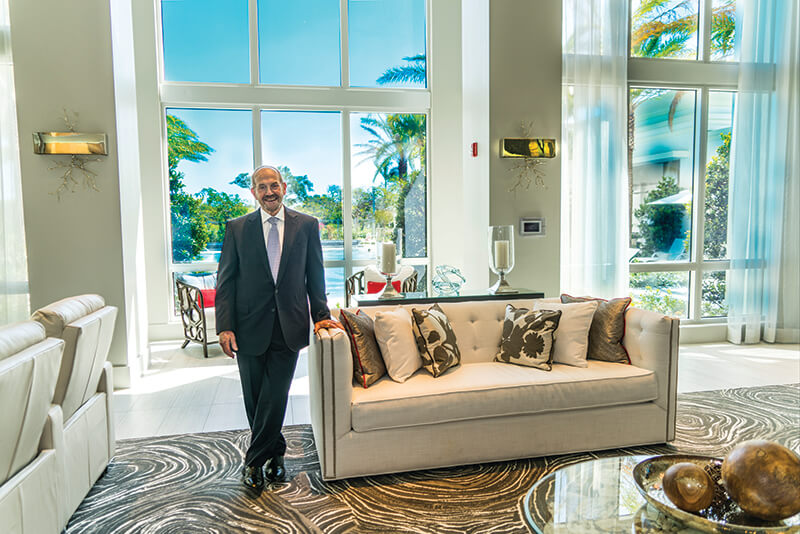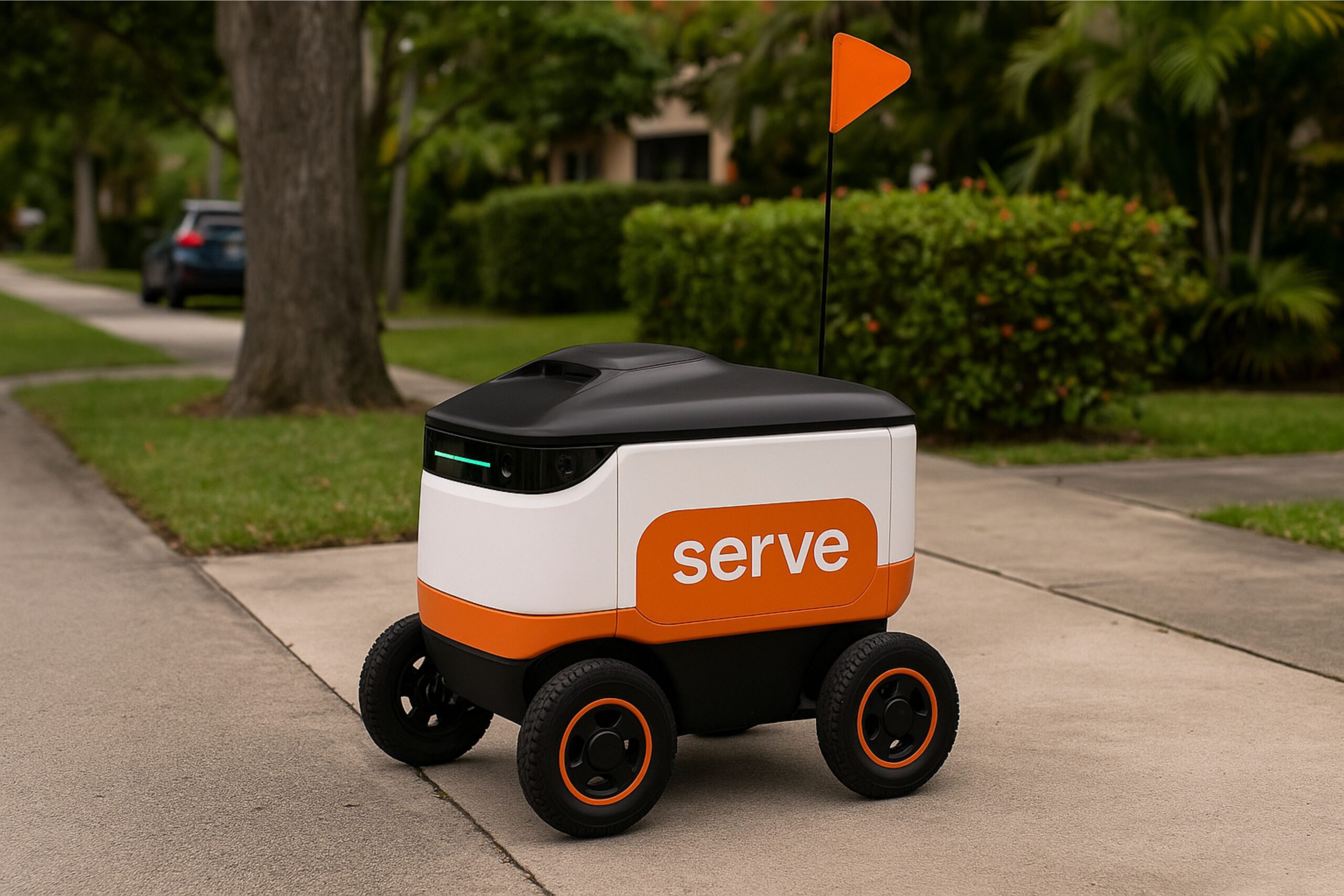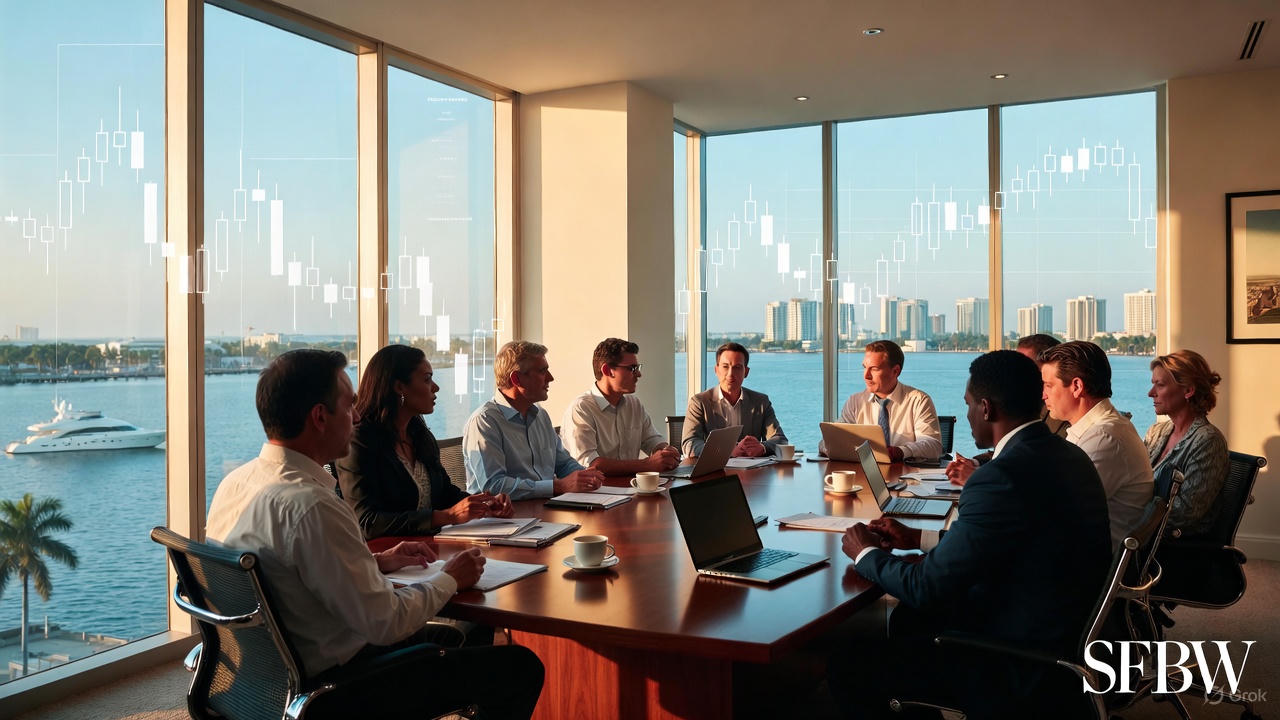Joel Altman survives turbulent real estate cycles to create cutting-edge projects
By Kevin Gale Photos of Joel Altman by Patrick Clinton
Joel Altman offers lessons in adaptability and perseverance as a residential developer who started his company in 1968.
Altman Cos. is one of the most prominent multifamily developers in South Florida, with $1.07 billion in projects under construction or in the pipeline. The Altis brand provides the types of amenities and residential experiences sought by childless millennials as well as families and retirees looking for a simple lifestyle.
SFBW caught up with Altman at Altis Boca Raton, a luxurious project on Military Trail that’s garnering 4½-star reviews (out of 5) on Google. The project reflects cutting-edge amenities, such as dog-washing stations, a spa with massage treatment rooms, and a postal center with special lock boxes for package deliveries.
Altman is the fourth generation of his family to be involved in construction and development. His father built single- and multifamily projects in Philadelphia. He worked for an apartment developer while getting a degree in building construction at Michigan State University. After graduation, he developed an 84-unit student apartment project in Michigan, working out of a spare bedroom before buying a rusty semitrailer from a junkyard to be his office.
These days, Altman Cos. has 16 projects under development or in the pipeline, from Texas and Central Florida to South Florida. To manage all of that, it helps that Altman is a pilot with a Cessna Citation CJ3 jet.
The following is transcript of SFBW’s interview with Altman, which has been edited for clarity and brevity.
Altman Cos. was founded in 1968, so there have been many ups and downs in the world of development since then. How did you survive?
In 1974, we had a terrible situation. The prime rate went to 24 percent. In those days, we used to budget 12-percent interest for construction loans. You can imagine the shortfall. We had four jobs going. We had a lender, which was North American Mortgage Investors. I laid out the problem and laid out a solution. I told him I thought we could put together some syndication and raise more money, but I would need him to think about increasing loans. These were times when Florida was in very difficult times—there were a lot of failures. He told me, “I tell you what: I’m going to give you the increased mortgage and I want you to enter into what is called a ‘hey, boy’ contract—’hey, boy, go here or go there, because I have a lot of problems.’ ”
It’s basically being forthright, recognizing the problem, coming up with a solution and not making it a problem for the lenders. It has been tried and true all throughout my career.
How did you end up in Florida?
It goes back to my “hey boy” contract in 1974, because North American had done financings in Largo, Fort Myers and Jacksonville and asked me to come down. The development in Largo was a disaster. Subcontractors hadn’t gotten paid and they burned part of the place. There was old equipment and weeds were almost as tall as you.
I took the family to nearby Clearwater for Thanksgiving. By March, we were under construction. North American gave us the deed and allowed us to finish the project. I set up an apartment there as the Florida regional office.
My father resided in Boca Raton. He and my stepmother would look for sites. And when I would come down, he would show me the sites. At the beginning of 1983, we found two sites. One in Boca Raton on Military Trail to the south, where we did Boca Arbor Club with 300 plus units, and another site in Plantation.
Through 1987, I would commute back and forth, and we had a team down here building Arbor Club and Lakepointe at Jacaranda. In 1987, I made the decision I was going to move here full time. We had a lot invested and a lot going on. Michigan didn’t have much going on.
You have a lot of projects in Michigan and Florida and one in Austin. Where do you see future opportunities geographically?
We have developed here constantly since the early ’80s, and we did a whole slew of apartments in suburban Chicago. We did four jobs in Raleigh [North Carolina] and three in Charlotte, and developed in Tennessee. Obviously, as things got difficult [during the recession], we pulled in our horns and concentrated on Florida, and used Florida as the means to come back and regenerate the company.
We are building a lot in Florida: Tampa, Boca Raton, Pembroke Pines, a second development in Hialeah and two in Kendall. We have a deal going in Little Havana on Eighth Street starting next year. We’ve been in in Orlando, Tampa, Gainesville, Palm Bay and Melbourne. Miramar is the end of this year with two developments next to each other—two different product types and brands.
Who do you typically partner with on development projects?
We have done syndications and had friends-and-family money where we raised the equity. Some of those partnerships in the early ’70s in Michigan still exist today. We still own those properties and they are doing great.
The 1986 tax act made syndication and tax shelters passé. We’re very fortunate that we were approached by Northwest Mutual. We did many deals here; in Chicago; Coral Springs; Naperville, Illinois; Kendall; and West Palm Beach. That kind of opened the door for us and there were other institutions who recognized what we were doing. We have always co-invested in every transaction.




How do you determine your exit strategy?
We did two or three deals with OPERS, the Ohio public pension fund. They wanted in and out. We are doing another deal with them now. They did a deal in 2010 in Lutz. They were a joint venture partner. It’s a nine-year relationship. What drives that is the money they manage has an investment profile that they want.
That’s contrasted to this development through [the real estate investment company] GID—they are the managers for CalPERS [the California Public Employees Retirement System]. CalPERS is a partner in this development. At a point in time, they will get to buy out a portion of our interest and we have an interest that we can maintain in parallel with them into the future. They are long-term holders. They are willing to take the construction risk.
Institutional equity seems to have a keen interest in South Florida now. How has that evolved over time?
We went through a period when all the institutional lenders said they wanted to do garden apartments. It was safer and quicker than high-rise. Then the cycle went to, “If it isn’t urban, we don’t want to look at it.” Now they are back saying urban has to be real special, but we really prefer to do garden. We’ve always done both.
What are the key features and amenities you consistently want to offer with the Altis brand?
Right now, there’s an amenity war going on—to one-up the last developer with the next development. This property, even as new as it is and as well as amenitized as it is, I already have ideas for the next one. If we do something great, the next guy is going to copy us. So, we said living is experiential. We want to contribute to an exceptional living experience.
With this room [a small conference room] you can sit around and play poker. You can have a wine tasting. You can have a conference just like we are. So, this works very well. In Kendall, they don’t play poker. This table doesn’t work. You have to have a dominos table. So, the room is wine tasting, dominos and conference.
This building has the café out there. It’s not just a café, but a club room like a bar with old games. You can open windows and use it for parties to serve outside. For a large gathering, those doors open, so this room and the other room flow together.
The multipurpose room has a large-screen projector TV. You can do movies and big games. We have an electronic game room because a lot of the people who are adults, and maybe a little younger than me, grew up playing those games.
The next room is the gym. We have a full cadre of equipment and an indoor and outdoor yoga facility. We have cycles in there with an online program for fitness on demand. You can have trainers or go for a cycle ride over a prescribed course. Then, there’s an indoor spa with two treatment rooms. There’s a splash pool, a steam bath and a sauna.
We have a pet grooming area. There’s a blow salon, which is staffed. We have a bicycle storage room and a repair station. You can do it yourself, or they have a vendor that comes in and will do repairs on-site. There’s a dog spa that’s fully equipped with a tub and blower. A lady operates that. They also do pet walking.
We have a package receiver. People are under stress, wondering if they will get there before the office closes or not, so we had to put a package system in. They can get their packages 24/7. We have laundry package receivers and refrigerated package receivers because people are getting food over the internet. That’s a big amenity.
Altis boca raton seems to be an example of a suburban project on a street with the live-work-play qualities of a downtown area.
We call this “urban suburban.” We formed a partnership with Schmier and Feurring Properties. The partnership bought this land with the understanding that Schmier and Feurring would take the parcel for commercial [the site of the Park Place shopping center] and we would take residential. We planned the development together—the land planner and landscape architect are the same.
There’s a special entrance at the end of our building on the north end so residents can come down the elevator, go across the street and they are under cover throughout the whole shopping center, which has The Fresh Market on the south end.
Your wife, Beverly Raphael, president and CEO of RCC Associates, is a prominent figure in the contracting field, especially when building out retail and restaurant space. Since experiential design is so critical these days, do you bounce ideas off of each other?
We were the first to get ID & Design International to do residential. [IDDI of Oakland Park, which was previously profiled in SFBW, originally was noted for experiential retail designs.] Beverly is a general contractor that builds and the designers design. IDDI designs a restaurant and she’ll bid it and build it.
There’s a lot of creativity emerging when it comes to addressing the affordability issue, such as smaller units, curtailing parking, and even dorm-style units with private bedrooms. Do you think it will work?
The problem is land costs, construction costs and the large fees that most municipalities are charging. It’s very, very difficult to deliver something that is affordable at the relative size we are accustomed to.
What you are seeing in other metro areas is the size coming down, with the idea that at a given dollar amount, your rent-per-square-foot will go up and be able to support those costs.
I’ve heard about the sharing, and we at one time had designed some active senior housing that had two bedrooms. Each bedroom had its own entry and then where was an entry into the living, dining, kitchen area and those were shared. We have not done that in our housing today.
What we are doing in Little Havana is we are putting a lot of efficiencies in, but we have tried to design those efficiencies so they live like a one-bedroom without a door on the bedroom. There’s a sense of privacy.
Is the prospect of self-driving cars starting to affect design and locations?
We have got to get the cities to recognize that. The number of cars that are going to be on the road is going to be going down because of sharing and driverless cars. If you take this development, I think we have 660 parking space that this building wraps around. Those spaces cost about $15,000 a piece. If we only had to build 300, you can imagine what that does to costs.
What sort of charitable endeavors do you support?
I’ve been involved with the Boys & Girls Clubs since back in my Michigan days. A number of years ago, I arranged for the Boys & Girls Clubs to get three of our developments. I got financing for them. Out of the operational cash flow, they would get income for the program. We operate the properties for them, but the properties are in their name. We have had an opportunity to refinance the developments and, out of those refinancings, they have gotten very, very large sums of money.
Down here, I kept saying, I’m always writing checks for charities. I thought, ‘Why don’t I start one that takes care of and looks to children or young people that are disadvantaged.’ The particular one I got involved with was kids who were emancipating out of foster care. The vision was, we would assist them by creating a life plan so when they were emancipated out, they would have a plan as to where to go. Then there was an interest in the Dan Marino Foundation to take it over. They did that.
Today, I’m very active in the Boys & Girls Clubs of Broward County. We have a little group called “the generals.” We want to get kids in the trades, where there are great opportunities. If someone comes out of school and is a good welder, they can make $100,000.
How is the labor market in construction?
We are in a world of hurt. We can’t get enough manpower. Especially, now that the president has really put an emphasis, not wrongfully, [on making] our borders more secure. So, the Mexican labor force that came over here and worked illegally—whether they were picking grapes in California or pounding nails in drywall here—are not here anymore. ♦














